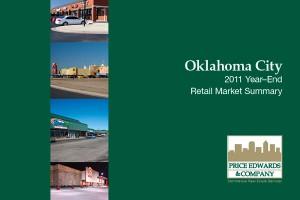
Price Edwards & Company is pleased to release its Oklahoma City 2011 Year-End Retail Market Summary which continues to be the most comprehensive report on retail properties for the area.
The Retail Market
The Oklahoma City retail market has seen a continuation of a marked improvement this past year. This is borne out both in our firm’s transactional activity and the year-end 2011 survey results.
Price Edwards manages and leases nearly 7 million square feet of retail space across Oklahoma; we generated a 20 percent increase in lease transactions this past year. The market vacancy at year–end dropped below 10 percent for the first time in years, ending the year at 9.8 percent. This is an improvement from 10.5 percent at mid-year and 11 percent at the end of 2010. Looking inside the numbers, the improvement can be attributed to the following:
- A number of vacant big boxes being filled;
- National tenants becoming more active after a 2-year hiatus;
- Limited new construction combined with the success of new projects, principally the Outlet Shoppes coming on line 100 percent occupied and a handful of existing property additions that were quickly occupied;
- Nationally, retail sales are now 20 percent above the 2009 trough and 5.5 percent above the pre-recession peak (not adjusted for inflation).
Three of the submarkets – Edmond, Moore-Norman, and North – are showing significant growth and vitality. The West Central submarket is close behind, particularly given the success to the Outlet Shoppes. The South and Northwest submarkets are stable, but given their established neighborhoods and less retail-friendly demographics, are seeing less activity with vacancies in the mid-teens. New product in the Eastern Oklahoma County submarket is generally full, while older centers have some vacancy.
Nationally, improvement was seen as well although it was more uneven and accompanied by more uncertainty. Garrick Brown, analyst for Chainlinks Retail Advisors - our national affiliation with the leading retail firms in other states, takes a closer look at the national picture on the back cover article.
Questions/Issues of Interest
As part of our year-end study, we wanted to address a number of questions or issues about which we are frequently asked: Is all the news good news? In a word, no.
There are a number of positives, as you would expect during a general economic recovery. However, national retailers are still being cautious, capital markets are tight, shoppers are still spending less, and more uncertainty remains than you’d like. Local mom and pop tenants have probably been hurt the most and will be the last group to recover. The market is moving in the right direction, but the ongoing recovery is somewhat uneven.
Outlet Shoppes of Oklahoma – why has it been so successful and what will be its long–term impact?
The initial sales of the Outlet Shoppes have been huge and probably surprised everyone a bit. We attribute them to a combination of factors: some new stores not previously in our market; discounters have typically done well in our market and an outlet mall plays to that demand; it’s a new concept having an in–town outlet mall; and, as noted, our market is doing better than we sometimes think. As to its longer-term impact, it’s too early to tell. Historically, retailers haven’t wanted outlet malls nearby because they tend to cannibalize their regional mall business and compete with their full price stores. Penn Square is such a juggernaut that we don’t see this being much of an issue, though the Outlet Shoppes could pull some sales away from Yukon and northwest Oklahoma City. Time will tell, although, we believe the Outlet Shoppes will continue to be successful and is a good addition to our market’s retail offerings.
What new retailers are coming to town or are expanding?
One of the signs of our market getting healthier is the number of retailers expanding or looking to our market for the first time. Gyms and grocery stores lead the expansion efforts. Gyms expanding include Gold’s Gym, Planet Fitness, Fitness 19 and the YMCA. LA Fitness is seeking sites as well. On the grocery front, everyone knows about Whole Foods opening; Sunflower has two locations and is looking for others; Aldi and Save-A-Lot have expansion plans; Sprouts continues to look in the market; the Fresh Market would like to be here as would Tulsa’s Reasors; Buy for Less & Crest are both expanding with their Market concepts; and, Walmart is planning additional grocery stores as well. Costco has said they would come if Oklahoma changed their liquor laws to allow them to sell wine; and, they might eventually come anyway. A number of other retailers are either actively looking in Oklahoma City or would like to be here, including Dick’s Sporting Goods, Home Goods, Sam Moon, Von Maur, Performance Bikes, Monarch Dental, Urban Outfitters, The Container Store, Nordstrom Rack and a number of smaller tenants and restaurants. >With limited vacancy in good locations, many of these will either have to build stand-alone stores or wait until a new development breaks ground.
When will we see new construction?
Construction the last couple of years has been limited to smaller additions to existing centers with the notable exception of the 348,000 square foot Outlet Shoppes. This past year, University North Park has added an 8,000 square foot strip and a couple of outparcel buildings; Fritts Farm is nearing completion of a 12,000 square foot small shop building; and, Shoppes at Moore finished their last couple of buildings. A few stand–alone buildings are new as well, including a Walmart Neighborhood Market in Midwest City, and Dave & Busters on Northwest Highway, and the planned Walmart Supercenter at Choctaw’s Town Square. Newer centers are uniformly well occupied. With the above tenants, and others, looking for space in our market, we anticipate the announcement of two or three new developments this upcoming year. The most likely locations will be the Memorial corridor and I-35 in Edmond. Expect continued expansion of existing projects in Moore, Norman and Midwest City. While there is demand for new product, development remains difficult given continued tight capital markets, rental rates that have yet to return to pre-recession levels, and caution among national retailers.
What is the outlook for the grocery market?
The above list of grocers expanding and entering our market will greatly enhance shopping choices for consumers and is filling several of the larger vacant spaces. A number of these grocers are specialty grocers, which have smaller stores and focus more on fresh product and prepared foods. We see a three to five year window of these expansions and increased competition. Given that Walmart, up until recently, had nearly 60 percent grocery market share, the additional choices and competition are welcome. As in all things retail, there will be winners and losers based upon location and the reception the market gives these different concepts. Downtown grocery is always a topic of interest. A smaller, local limited product grocer or two may open downtown in the next couple of years, starting with Native Roots at the Level Apartments; but, until there are more people living downtown, no full-service or national grocer is expected to be interested. A remodel of the Homeland at 17th and Western is a possibility.
What does the future hold for Crossroads Mall?
The Mall was recently purchased from the lender by a local group of investors. The Mall is being re-positioned as a mixed-use value-retail center. A combination of physical improvements, marketing, and affordable rent will be used to attract value-oriented retailers and other users to the Mall. The 1.2 million square foot mall (this includes all the outparcels and various owners) contains nearly 900,000 square feet of vacancy and is currently not included in our survey numbers.
Where do you see Internet sales going and what is the prospect for sales tax on Internet sales?
Currently, Internet sales are approximately 9 percent of total retail sales; and, Internet sales have been growing at a double–digit rate. >A lot has been written about this threat to brick and mortar stores. Over the next several years, expect Internet sales to continue to grow rapidly, but they will begin to grow at a declining rate. The biggest winners will be retailers who figure out how to integrate their web sites and Internet sales/marketing with their stores. A bill is pending at the Federal level that would allow states to charge sales taxes on Internet sales. Whether this bill passes or not, we don’t know, but, it’s only a matter of time, particularly given the funding problems at the state and municipal level across the country.
Outlook for 2012 – We anticipate continued improvement in 2012 with further gains in market occupancy.
Stress remains in the market given national economic uncertainty and the problems retailers are having in other states. Local retailers have probably faced the most challenges this past year and have benefited the least from our improving market as they have not been able to reduce costs, increase advertising and implement other strategies that have helped national/regional retailers improve their performance. This will start to change in the upcoming year, as all retailers should begin to see the benefit of an improved market. This doesn’t mean that there won’t be store closures or weak performers. This is the nature of retail. In the aggregate, tenant sales are expected to increase at an increasing rate, market rents will begin to rise, and landlords will be in the best position they’ve been in the past four years to negotiate deals. As with the past two years, improvement won’t always seem readily evident as we are in the middle of it, but it will be real.
Survey Footnote:
Our survey tracks 27.4 million square feet in 231 buildings of over 25,000 square feet and 13.0 million square feet of stand-alone buildings for a total market of $40.4 million square feet.
There continues to be a significant number of smaller strip centers in the market (under 25,000 square feet in size). We would estimate there are easily 3 million square feet of these properties in the market.




